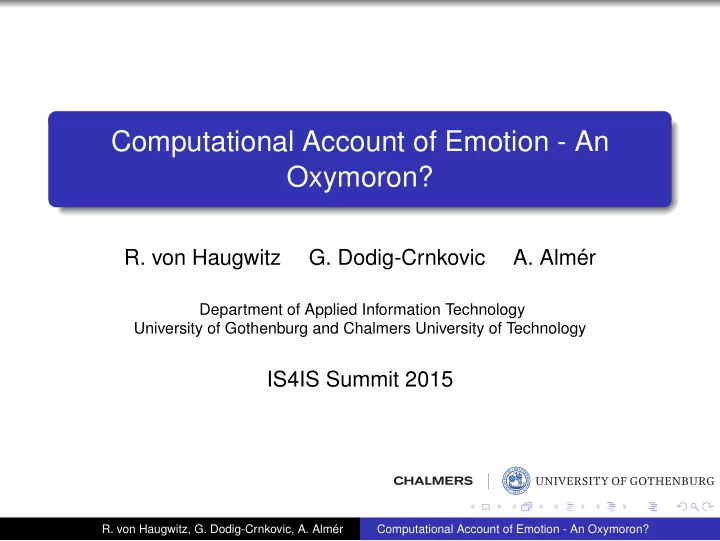

Computational Account of Emotion - An Oxymoron? R. von Haugwitz G. Dodig-Crnkovic A. Almér Department of Applied Information Technology University of Gothenburg and Chalmers University of Technology IS4IS Summit 2015 R. von Haugwitz, G. Dodig-Crnkovic, A. Almér Computational Account of Emotion - An Oxymoron?
Criticism of Naturalism Sensory input and emotions often considered subjective and qualitative “Qualia” Emotion defies computational explanation because: Computation is taken as symbol manipulation Emotion cannot be objectively expressed with symbols Emotion therefore sometimes excluded from cognition R. von Haugwitz, G. Dodig-Crnkovic, A. Almér Computational Account of Emotion - An Oxymoron?
Our Stance Emotions and feelings naturally belong to cognition and can be explained computationally Emotion is more fundamental than symbol manipulation Cognition should be understood as computation in a wider sense than symbol manipulation Symbolic and subsymbolic computation R. von Haugwitz, G. Dodig-Crnkovic, A. Almér Computational Account of Emotion - An Oxymoron?
The Mind-Body Problem Mind = body? Mind is a process, not an object “Minds are what brains do” (Minsky, 1988) The embodied brain is necessary and sufficient for, but not equal to, the mind R. von Haugwitz, G. Dodig-Crnkovic, A. Almér Computational Account of Emotion - An Oxymoron?
Naturalism and Qualia Is naturalism incapable of explaining qualia? A simple feature of a natural organism No two individuals are identical May be unique to each individual, but so is e.g. handwriting Can be communicated and interpreted, even if the difference is big Cognition is not the brain R. von Haugwitz, G. Dodig-Crnkovic, A. Almér Computational Account of Emotion - An Oxymoron?
Generative Reduction Goal: understanding cognition, including emotion and feeling, from the molecular level up Reduce complex processes to interactions between simpler processes Molecules and chemical processes in networks of molecules Cells and aggregates of cells Organisms and social networks Yes, including Facebook Model cognitive processes emerging on different scale levels in living organisms based on understanding of the underlying levels R. von Haugwitz, G. Dodig-Crnkovic, A. Almér Computational Account of Emotion - An Oxymoron?
Generative Reduction This goal is still far off, but starting from the simplest form of cognition in the single cell, we can use that knowledge to understand the next level of organisation, and so on R. von Haugwitz, G. Dodig-Crnkovic, A. Almér Computational Account of Emotion - An Oxymoron?
Background of Emotion The chemicals that mediate emotion are used to coordinate behaviour of single cells in bacterial colonies Neurotransmitters: short range Hormones: long range Emotion is used to orchestrate and direct cognitive subprocesses Performance of the organism thus increases Meta-computing, optimisation Guides behaviour without the need to resort to slow symbolic reasoning R. von Haugwitz, G. Dodig-Crnkovic, A. Almér Computational Account of Emotion - An Oxymoron?
The Evolution of Emotion Image from Nesse, R.M. 2004. Natural selection and the elusiveness of happiness. Philosophical transactions of the Royal Society of London. Series B, Biological sciences . 359, 1449 (2004), pp. 1333–1347. R. von Haugwitz, G. Dodig-Crnkovic, A. Almér Computational Account of Emotion - An Oxymoron?
The Need to Modulate Learning Environment dynamics may change rapidly for complex organisms Failure to adapt could mean death Long-term or short-term optimisation? Exploration or exploitation? Quick or slow learning? Depends on the situation! R. von Haugwitz, G. Dodig-Crnkovic, A. Almér Computational Account of Emotion - An Oxymoron?
Emotion and Learning The neuromodulators responsible for human emotion have also been shown to modulate (reinforcement-)learning metaparameters (Doya, 2002): Acetylcholine: learning rate Noradrenalin: exploration/exploitation tradeoff Serotonin: discounting factor Dopamine: discrepancy between expected and actual reward R. von Haugwitz, G. Dodig-Crnkovic, A. Almér Computational Account of Emotion - An Oxymoron?
Appraisal Theory Appraisal of the situation along a number of objective dimensions gives rise to (some) emotions E.g. conduciveness, unpredictability, control, discrepancy from expectation... A point in multidimensional space Emotion is connected to the value function, and thereby to learning and optimisation R. von Haugwitz, G. Dodig-Crnkovic, A. Almér Computational Account of Emotion - An Oxymoron?
Summary Emotion as a cognitive process can be connected to its biochemical generative basis This does not reduce emotion to a chemical any more than naturalism reduces mind to the brain Emotion can – and perhaps must – be studied as a computational process on all levels of abstraction There is no need for mystification R. von Haugwitz, G. Dodig-Crnkovic, A. Almér Computational Account of Emotion - An Oxymoron?
Recommend
More recommend